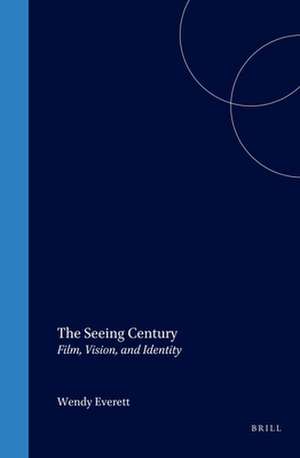The Seeing Century: Film, Vision, and Identity: Critical Studies, cartea 14
Wendy Everetten Limba Engleză Paperback – 31 dec 1999
Rejecting the compartmentalisation that has traditionally marked film studies, and confronting an impressively eclectic range of material, fifteen essays by leading academics from around the world cut across ‘divergent’ cultures, languages, and genres: mainstream Hollywood rubs shoulders with low-budget Icelandic or Sicilian cinema, and the popular and the esoteric feature alongside each other. In this way, the reader is offered a stimulating overview which directly addresses the contradictions and ambiguities inherent in the relationship between film and identity, and reveals the vibrancy of contemporary film debate, to which The Seeing Century makes an important and thought-provoking contribution.
Din seria Critical Studies
-
 Preț: 313.56 lei
Preț: 313.56 lei -
 Preț: 337.11 lei
Preț: 337.11 lei - 15%
 Preț: 372.69 lei
Preț: 372.69 lei -
 Preț: 268.89 lei
Preț: 268.89 lei -
 Preț: 212.87 lei
Preț: 212.87 lei - 18%
 Preț: 575.81 lei
Preț: 575.81 lei - 18%
 Preț: 565.66 lei
Preț: 565.66 lei - 15%
 Preț: 439.97 lei
Preț: 439.97 lei - 15%
 Preț: 518.28 lei
Preț: 518.28 lei - 15%
 Preț: 403.13 lei
Preț: 403.13 lei -
 Preț: 307.09 lei
Preț: 307.09 lei - 18%
 Preț: 546.36 lei
Preț: 546.36 lei - 18%
 Preț: 581.68 lei
Preț: 581.68 lei - 15%
 Preț: 482.72 lei
Preț: 482.72 lei -
 Preț: 405.42 lei
Preț: 405.42 lei - 18%
 Preț: 550.27 lei
Preț: 550.27 lei - 15%
 Preț: 505.71 lei
Preț: 505.71 lei - 18%
 Preț: 640.08 lei
Preț: 640.08 lei - 18%
 Preț: 785.09 lei
Preț: 785.09 lei - 18%
 Preț: 654.70 lei
Preț: 654.70 lei
Preț: 200.63 lei
Nou
Puncte Express: 301
Preț estimativ în valută:
38.40€ • 39.94$ • 32.18£
38.40€ • 39.94$ • 32.18£
Carte indisponibilă temporar
Doresc să fiu notificat când acest titlu va fi disponibil:
Se trimite...
Preluare comenzi: 021 569.72.76
Specificații
ISBN-13: 9789042014848
ISBN-10: 9042014849
Dimensiuni: 155 x 230 mm
Greutate: 0.39 kg
Editura: Brill
Colecția Brill
Seria Critical Studies
ISBN-10: 9042014849
Dimensiuni: 155 x 230 mm
Greutate: 0.39 kg
Editura: Brill
Colecția Brill
Seria Critical Studies
Cuprins
1. Wendy EVERETT: Introduction From Frame to Frame: Images in Transition
Section 1: (De)constructing History: Memory, Language, and Identity
2. Phil POWRIE: The ‘family portrait’, trauma and the punctum in Distant Voices, Still Lives (1988)
3. Peter WAGSTAFF: The Dark Side of Utopia: Word, Image, and Memory in Georges Perec’s Récits d’Ellis Island: histoires d’errance et d’espoir
4. Christopher SHORLEY: History, Memory, and Art in Louis Malle’s Au revoir, les enfants
Section 2: Imaging the Self: Personal and National Identities
5. Wendy EVERETT: Mapping Iceland or the Identity of Space: Cold Fever
6. Gretchen BISPLINGHOFF: Irish Images: Constructs of Film Space/Time
7. Ernie HAMPSON: Mocking the Mafia: Ciprì and Maresco’s Sicilian Apocalypse
8. Ann JÄCKEL: Too Late? Recent Developments in Romanian Cinema
9. María CAMÍ-VELA: From ‘Reespañolear’ to ‘Europeizar’ : The Subversion of Francoist Mythology in La flor di mi secreto (The Flower of my Secret) by Pedro Almodóvar’
10. Patrick WILLIAMS: ‘Entering and leaving modernity’ - Utopia and dystopia in Mambety’s Touki Bouki and Hyènes
Section 3: Gendered Visions: Sexuality, Identity, and Representation
11. Susan HAYWARD: Luc Besson’s Cinquième élément (1997) and the Spectacular: The City-Body and the Sci-Fi movie
12. Lorna FITZSIMMONS: Of ‘Broken Wall, the Burning Roof and Tower’: Gyno-Turning in Limit Up and Svankmajer’s Faust
13. Elisa BUSSI: Voyages and border crossings: Jane Campion’s The Piano (1993)
14. Steve WHARTON: Pédés et polémiques: Faggots and Fireworks – Les Nuits fauves and its moral(ity)
15. Raya MORAG: ‘Life-Taker Heart-Breaker’: Mask-ulinity and/or Femininity in Full Metal Jacket
Bibliography
Index
Section 1: (De)constructing History: Memory, Language, and Identity
2. Phil POWRIE: The ‘family portrait’, trauma and the punctum in Distant Voices, Still Lives (1988)
3. Peter WAGSTAFF: The Dark Side of Utopia: Word, Image, and Memory in Georges Perec’s Récits d’Ellis Island: histoires d’errance et d’espoir
4. Christopher SHORLEY: History, Memory, and Art in Louis Malle’s Au revoir, les enfants
Section 2: Imaging the Self: Personal and National Identities
5. Wendy EVERETT: Mapping Iceland or the Identity of Space: Cold Fever
6. Gretchen BISPLINGHOFF: Irish Images: Constructs of Film Space/Time
7. Ernie HAMPSON: Mocking the Mafia: Ciprì and Maresco’s Sicilian Apocalypse
8. Ann JÄCKEL: Too Late? Recent Developments in Romanian Cinema
9. María CAMÍ-VELA: From ‘Reespañolear’ to ‘Europeizar’ : The Subversion of Francoist Mythology in La flor di mi secreto (The Flower of my Secret) by Pedro Almodóvar’
10. Patrick WILLIAMS: ‘Entering and leaving modernity’ - Utopia and dystopia in Mambety’s Touki Bouki and Hyènes
Section 3: Gendered Visions: Sexuality, Identity, and Representation
11. Susan HAYWARD: Luc Besson’s Cinquième élément (1997) and the Spectacular: The City-Body and the Sci-Fi movie
12. Lorna FITZSIMMONS: Of ‘Broken Wall, the Burning Roof and Tower’: Gyno-Turning in Limit Up and Svankmajer’s Faust
13. Elisa BUSSI: Voyages and border crossings: Jane Campion’s The Piano (1993)
14. Steve WHARTON: Pédés et polémiques: Faggots and Fireworks – Les Nuits fauves and its moral(ity)
15. Raya MORAG: ‘Life-Taker Heart-Breaker’: Mask-ulinity and/or Femininity in Full Metal Jacket
Bibliography
Index
